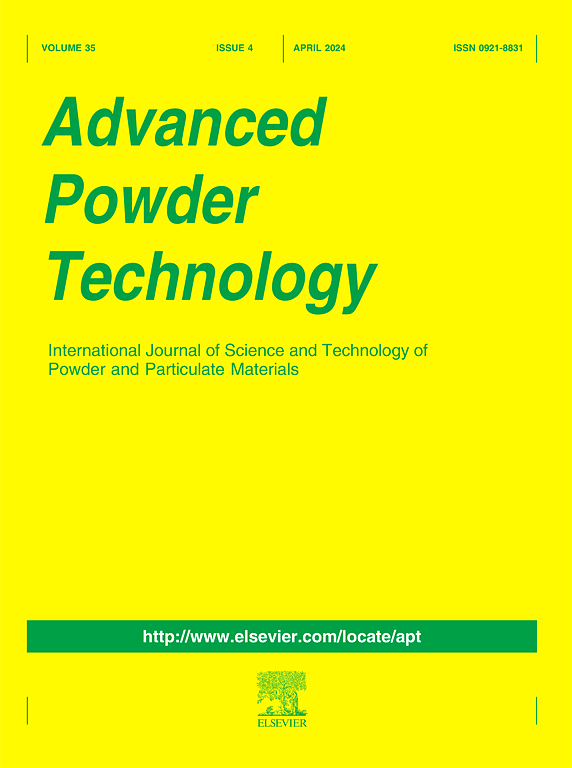揭示双z型MIL-100(Fe)@Bi2MoO6/MoS2异质结在降解酸性蓝92偶氮染料中的光催化性能
IF 4.2
2区 工程技术
Q2 ENGINEERING, CHEMICAL
引用次数: 0
摘要
Bi2MoO6是一种很有前途的水后处理光催化剂。然而,它的有效性受到快速电子-空穴复合和对可见光敏感性差的限制。本研究采用水热法制备了MIL-100(Fe)@Bi2MoO6/MoS2三元复合材料。首先,利用二硫化钼作为Bi2MoO6纳米片的稳定框架,合成了纳米花状Bi2MoO6@MoS2结构。这种结构增强了光吸收,增加了催化活性位点的数量。将MIL-100(Fe)掺入二元光催化剂中,形成了核壳结构,增加了表面面积,减少了电子-空穴复合。表征技术证实Bi2MoO6和MIL-100(Fe)分别成功固定在MoS2和二元复合材料表面。MIL-100(Fe)@Bi2MoO6/MoS2三元复合材料在降解不可生物降解污染物方面表现出优异的光催化活性,在可见光下对酸性蓝92的降解率达到82%,而纯Bi2MoO6的降解率为40%。光催化活性的提高主要归功于MIL-100(Fe)@Bi2MoO6/MoS2复合材料的合成,该复合材料促进了高效的电子空穴分离和转移。根据活性自由基捕获实验,鉴定出最活跃的活性物质是光生成的O2•−,h+。基于清除剂实验结果,探讨了MIL-100(Fe)/Bi2MoO6/MoS2异质结构光催化活性提高的潜在机制。本文章由计算机程序翻译,如有差异,请以英文原文为准。

Revealing the photocatalytic performance of the dual Z-scheme MIL-100(Fe)@Bi2MoO6/MoS2 heterojunction in the degradation of Acid Blue 92 azo dye
Bi2MoO6 is recognized as a promising photocatalyst for water post-treatment. However, its effectiveness is limited by rapid electron-hole recombination and poor sensitivity to visible light. In this study, a MIL-100(Fe)@Bi2MoO6/MoS2 ternary composite was synthesized via hydrothermal method. Initially, a nanoflower-like Bi2MoO6@MoS2 structure was synthesized, utilizing MoS2 as a stable framework for Bi2MoO6 nanoflakes. This configuration enhances light absorption and increases the number of catalytic active sites. Incorporation of MIL-100(Fe) into the binary photocatalyst creates a core–shell structure that increases the surface area and reduces electron-hole recombination. The characterization techniques confirm the successful immobilization of Bi2MoO6 and MIL-100(Fe) on the surface of MoS2 and the binary composite, respectively. The MIL-100(Fe)@Bi2MoO6/MoS2 ternary composite exhibits superior photocatalytic activity in degrading nonbiodegradable pollutants, achieving 82 % degradation of Acid Blue 92 under visible light, compared to 40 % of pure Bi2MoO6. The improved photocatalytic activity is primarily attributed to the synthesis of MIL-100(Fe)@Bi2MoO6/MoS2 composite, which facilitates efficient electron-hole separation and transfer. According to active radical trapping experiments, the most active reactive species identified are photogenerated O2•−, h+. A potential mechanism underlying the improved photocatalytic activity of the MIL-100(Fe)/Bi2MoO6/MoS2 heterostructure has been explored and discussed based on the results of the scavenger experiments.
求助全文
通过发布文献求助,成功后即可免费获取论文全文。
去求助
来源期刊

Advanced Powder Technology
工程技术-工程:化工
CiteScore
9.50
自引率
7.70%
发文量
424
审稿时长
55 days
期刊介绍:
The aim of Advanced Powder Technology is to meet the demand for an international journal that integrates all aspects of science and technology research on powder and particulate materials. The journal fulfills this purpose by publishing original research papers, rapid communications, reviews, and translated articles by prominent researchers worldwide.
The editorial work of Advanced Powder Technology, which was founded as the International Journal of the Society of Powder Technology, Japan, is now shared by distinguished board members, who operate in a unique framework designed to respond to the increasing global demand for articles on not only powder and particles, but also on various materials produced from them.
Advanced Powder Technology covers various areas, but a discussion of powder and particles is required in articles. Topics include: Production of powder and particulate materials in gases and liquids(nanoparticles, fine ceramics, pharmaceuticals, novel functional materials, etc.); Aerosol and colloidal processing; Powder and particle characterization; Dynamics and phenomena; Calculation and simulation (CFD, DEM, Monte Carlo method, population balance, etc.); Measurement and control of powder processes; Particle modification; Comminution; Powder handling and operations (storage, transport, granulation, separation, fluidization, etc.)
 求助内容:
求助内容: 应助结果提醒方式:
应助结果提醒方式:


